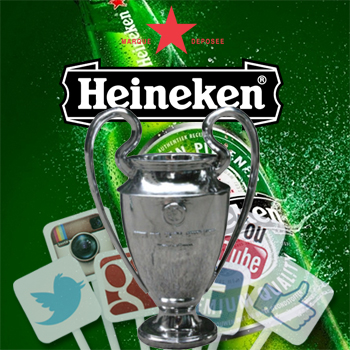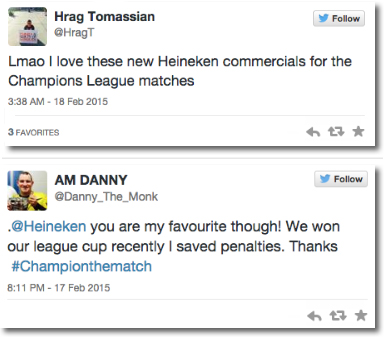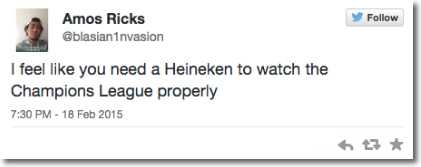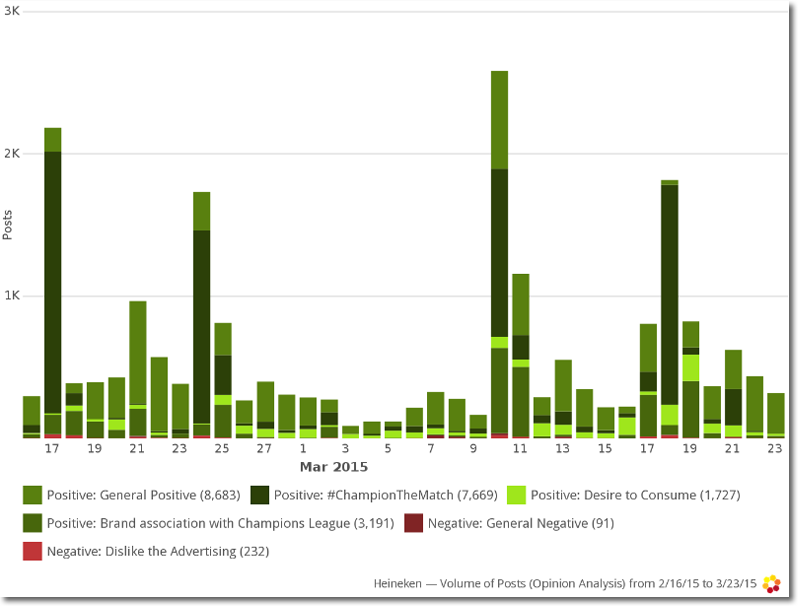Quantifying the Impact of a Social Campaign through Social Media: Heineken

Since February 16, 2015, 31,000 conversations worldwide have been generated around Heineken, with major spikes occurring during the Champions League evenings and peaks of around 3,000 posts during the games.
Heineken Social Media Campaigns
At the start of any season Cristiano Ronaldo’s football manager will, I’m sure, sit him down and say, ‘Cristiano, I want 30 goals from you this season’ and Cristiano will reply in his ‘I’m the greatest footballer of all time’ voice and say, ‘I’ll give you 50’.
The example I’ve used is, I admit, extremely simplistic but the point is that the management has made clear Cristiano’s objective and the metric we use, goals scored, is easy to measure in order to determine whether his campaign has been successful (probably) or not (here’s hoping).
However, the social media campaigns that Heineken has embarked on, starting with its ‘Share the Sofa’ campaign and now moving on to ‘Champion the Match’, aim to achieve the beer giant’s lofty ambition of being the only beer associated with the Champions League.
Brand awareness and loyalty are the names of the game. But how can we quantify the emotional impact a marketing campaign has on the consumer in the same way Real Madrid quantify the goals scored by Cristiano?
By undertaking a deep analysis of social data, you can uncover rich insights from the consumer which allow you to truly determine HOW they have emotionally engaged with your marketing efforts.
Heineken has been a sponsor of the Champions League since 2005. Its partnership with Europe’s most prestigious football competition has helped the Dutch beer brewer continue to build brand awareness in European and African markets, where it is the main player, but also to boost its presence in higher-growth emerging markets in Central America and Asia.
Innovative, catchy TV commercials coupled with engaging social media entertainment and competitions have played an enormous part in creating buzz around the brand with the consumer and its latest installment is no different.
Since February 16th, 31,000 conversations worldwide have been generated around Heineken. Major spikes occur during the Champions League evenings with peaks of around 3,000 posts during these nights.
The launch of Heineken’s ‘Champion the Match’ campaign aims to build on the success of its predecessor ‘Share the Sofa’. Moving away from just focusing on the 90-minute game, Champion the Match content is being pushed out the entire evening; fans can chat football, enjoy additional entertainment and have the chance to win prizes. All of this takes place before, during, and after the game.
Heineken hopes these additional components, created by its agencies DDB and Tribal Worldwide Amsterdam, will encourage fans with their friends to host their own Champions League nights which center around football and the beer brand. Just like Patrick Kluivert does here…
The shift by the brewer is now towards making ‘Heineken’ and ‘Champions League night’ synonymous. What’s more, their exploits seem to be working.
This consumer has expressed their emotional attachment to the brand on Champions League night – cue Gazza’s legendary 1996 dentist chair/water bottle goal celebration taking place in Heineken’s marketing office!
With this one post we have delved deeper into the analysis of the consumer psyche to understand the relationship they have with the Heineken brand. Valuable stuff.
With Crimson Hexagon’s Forsight platform, I’ve chosen to categorize this post type as ‘Brand association with Champions League’.
The tool’s ability to recognize patterns in language allows us to bucket thousands of posts which express any reference to consuming Heineken whilst watching the Champions League.
Out of the 31,000 posts about Heineken, 17,500 were relevant for this analysis.
The categories “#ChampionTheMatch’ and ‘Brand association with Champions League’, provide us with metrics that can be used to determine how effective Heineken has been at increasing brand awareness and brand loyalty to Champions League evenings.
The analysis shows us that 31% of the 17,000 posts actively participated with the hashtag and 15% associate the Champions League with consuming Heineken.
Download the Paper: The Four C’s Of Social Media For The C-Suite
Going back to my football analogy (apologies, when I’m on a roll…), one of Cristiano’s objectives put in place by management was goals scored which, for Heineken, I’ve likened to its campaign objective of building brand loyalty. But surely we also want to have some sort of an idea about the metric that will ultimately determine whether or not Real Madrid survive in the division; points scored.
For Heineken, like for any company, this metric is revenue. While we can’t prove that there is a direct link to the social campaign and an increase in revenue, we can quantify the desire to consume/intent to purchase that consumers express via social platforms;
The analysis tells us that since 16th February, 8% of consumers’ posts on social media, that are associated to Heineken and their Champions League marketing, have expressed a desire to consume the product. By comparing this with historical data we gauge whether an increase in intent has occurred over the time period or not.
Conclusion
Regardless of whether you are targeting consumers (customers) through social media or not, social is a platform where consumers come to voice their experiences, questions, recommendations, and emotions about and towards brands on a daily basis.
By quantifying the qualitative data that the consumer is providing, you can gain valuable insights into the impact of campaigns which will, in time, allow you to build a closer and more effective relationship with the consumer, your customer.
About the Author

Guy Purchase is the Senior Success Manager Advertising Product at Sprinklr, ensuring that global enterprise businesses yield positive ROI from their SaaS tech investment. He understands the client's business objectives and then maps these objectives to products that return positive outcomes. He's also responsible for tracking that these outcomes are delivered as well as presenting back the value realization to the client. Working with Sprinklr’s advertising product he's responsible for a book of business of clients across the UK, Northern Europe, and the US.
Prior to Sprinklr, he worked at Crimson Hexagon (now part of Brandwatch), an AI-powered consumer insights company based out of Boston, Massachusetts. He has lived and worked in Germany and Spain, and is fluent in both languages.
He has a Bachelor of Science (BSc) in the Study of Economics with German and a Diploma in International Studies Grade 2:1 from Loughborough University. Additionally, he has a Bachelor's Degree in the study of Secondary Education and Teaching from Kingston University. He now resides in London, UK.
Related Article: The Social Side of Supply Chain Management
Article Topics
Crimson Hexagon News & Resources
Microsoft to Acquire LinkedIn for $26.2 Billion The Four C’s Of Social Media For The C-Suite Quantifying the Impact of a Social Campaign through Social Media: Heineken 6 Ways Social Insights Inform Marketing Strategy A Method of Automated Nonparametric Content Analysis for Social ScienceLatest in Technology
SAP Unveils New AI-Driven Supply Chain Innovations U.S. Manufacturing is Growing but Employment Not Keeping Pace The Two Most Important Factors in Last-Mile Delivery Spotlight Startup: Cart.com is Reimagining Logistics Walmart and Swisslog Expand Partnership with New Texas Facility Taking Stock of Today’s Robotics Market and What the Future Holds Biden Gives Samsung $6.4 Billion For Texas Semiconductor Plants More Technology


















